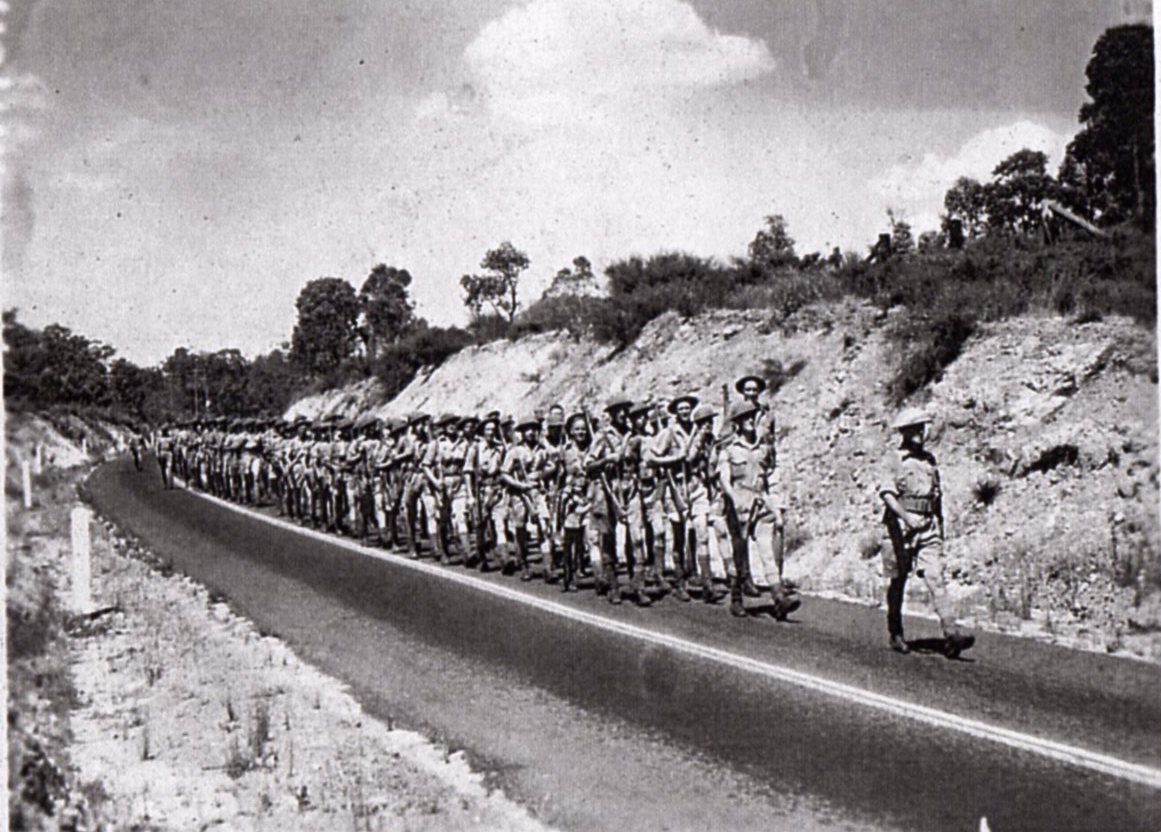
‘A’ Company marching to Perth from Northam March 4th 1941
Eighty years ago on the 7th November 1940 it was announced by the Minister for the Army, Sir Percy Spender, that Lt-Col M.J.Anketell, was to form and train the 2/4th Australian Machine Gun Battalion. The decision to enlist and send Australian forces overseas to support Britain, following the outbreak of war in 1939, was traditional but not automatic. Home defence, which was not a major issue in WW1, had now assumed a dramatically new dimension – with Japan the wild card in the deck.
By 1940 Australia had amassed 2 divisions of troops, the 6th Division, was in the Middle East and the 7th Division was training in Australia. Initially convinced by Churchill that the priority existed for the defence of the Middle East the 7th Division would not go to Malaya but would join the 6th Division in the Middle East. By May the Australian Government had authorised the formation of a new division, the 8th Division. It was this new Division that inherited the home defence role.
Stunned by positions in Europe and facing the grim prospect of the possible defeat of England. A world tragedy threatened to spill over into Australia’s own backyard. For thousands of young men, destined for the newly formed Division, filling up military camps all over Australia, there was no hint of the hopeless tasks they would be called upon to perform nor the tragic aftermath.
Western Australia’s 2/4th Machine Gun Battalion was raised as one of the support units for the ill-fated 8th Division. Formed with men from across the state, raised wholly from personnel already enlisted and training in Western Australia. They all came together at Northam military camp, east of Perth, where they carried out their initial training.
Whilst new enlistments still absorbed the early spirit of adventure and excitement, the reality of war and now the very real danger facing Australia added a new dimension to the recruitment program. No longer was it seen to be the responsibility of the young and footloose to shoulder the burden – every Australian was now committed. And they responded, with a dramatic increase in the 30/40 age group and in the number of married recruits, most with young families. Many shed years from their age to enlist. This was the backend of the 1930s depression – men wanted the security of a permanent job to provide for their families.
They came in all shapes, sizes, religious beliefs and backgrounds from all corners of the State. Equally divided at roughly 44% between City (and suburbs) and country (Geraldton to Esperance) with the remaining 12% coming from the Eastern and Northern Goldfields and the North West. Approximately 15% were originally from either the Eastern States or United Kingdom.
The average age for enlistment was 26 – with nearly half the recruits aged between 22 and 29 and the remainder (21 and under) (30 and over) roughly equal. Approximately 27% were married.
Lt-Col M.J.Anketell, at the time C.O. (Commanding Officer) 28th Bn. (Battalion) A.M.F. (Australian Military Forces), was directed to form a Machine Gun Battalion to consist of Bn. H.Q. (Headquarters) 4 M.G. (Machine Gun) Coys. (Companies) H.Q. Coy., attached personnel L.A.D. (Light Aid Detachment), A.A.M.C. (Regimental Medical Officer) and A.A.P.C (Postal Officer0. Personnel to be drawn from A.I.F. (Australian Imperial Force) and A.M.F. Training Units in camp in Western Australia.
The initial task was completed with the appointment of Maj. C.E.Green (late 28th Bn A.M.F.) as 2/IC and Capt.A.I.Hill (Staff College Duntroon) as Adjutant. Company Commanders and 2I/C’s were drawn from four A.M.F. Units – 25th , L.H., 11th and 28th Bns, A.M.F. – most of whom had considerable MMG (Motor Machine Gun) experience.
The Battalion was brought up to strength by the end of November and had moved into training quarters at Northam Camp consisting of:-
Battalion Headquarters – headquarters staff, medical section and regimental police.
Headquarters Companies:- No1 Platoon – Signals, No2 Platoon Protection and No3 Platoon Administrative
Four Vickers machine gun companies:-
‘A’ Company Headquarters and No’s 4,5,6 Platoons
‘B’ Company Headquarters and No’s 7,8,9 Platoons
‘C’ Company Headquarters and No’s 10,11,12 Platoons
‘D’ Company Headquarters and No’s 13,14,15 Platoons
(‘E’ Company Headquarters and No’s 1,2,3 Platoons – ‘E’ Company was reinforcements taken on strength at Fremantle 16.01.1941.)
Northam was their first home – kindergarten, primary and secondary stages of their Army training. They achieved much in this camp: outstanding physical fitness and co-ordination, self-confidence and the ability to hold their own, both as individuals and soldiers, in a tough and demanding school. They made friendships to treasure for the rest of their lives and traveled a long way on the road to achieving their ultimate goal – being soldiers on active service. Little did they know these mate-ships would be tested under the most appalling conditions as POW of Japan for 3 ½ years.
961 were to leave Australia – some were repatriated sick or injured before the fighting began, 133 were killed in action and 239 died as a P.O.W.s.
